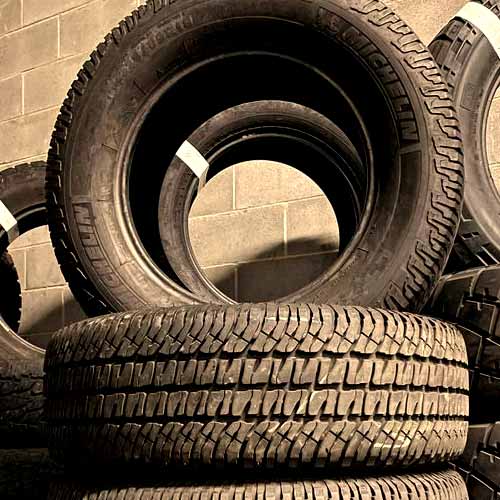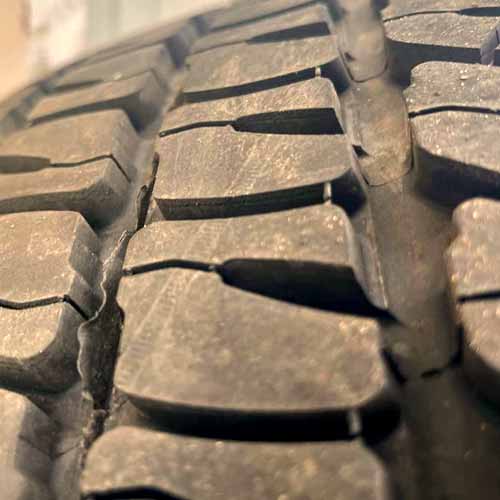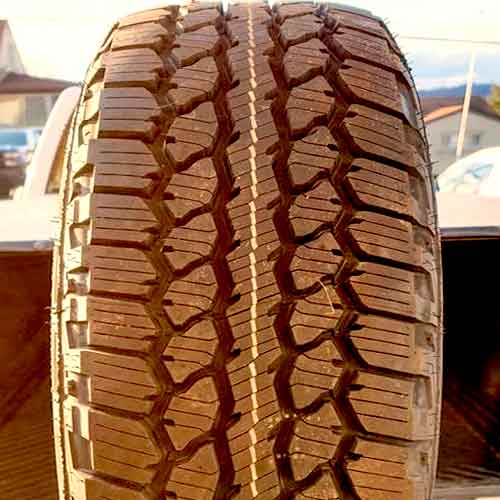The Michelin LTX AT2 and the Firestone Destination AT2 are very unique all-terrain tires, as they simply put, do great on multiple driving conditions. It doesn’t matter whether they are off road, on beaten paths or just providing the daily commute. Though there are some things to consider while looking at both. Let’s check them out.

In my expert opinion as a tire engineer, the Michelin LTX AT2 although takes the back seat when things are wet, it comes out better on dry roads, with superior traction and noise reduction capabilities. Moreover, the tire also takes the lead off-road with it’s powerful biting notches, presenting bigger chewing mouths. The Destination AT2 on the other side, if one of the best tires you can get for fuel efficiency and wet traction, and the tire also does great with snow, and sandy terrains.
Table of Contents
Sizes Facts
The Michelin LTX AT2 comes in just 20 limited sizes in 15 to 20 inches, with following specs.
- Speed ratings: R, S and T
- Load ratings: SL, XL, C, D and E
- Tread depth: 14 to 17/32″
- Weight range: 32 to 60 lbs
- Not rated with 3PMSF
- 60k miles warranty on all sizes
Detailed review of this tire: https://tiredriver.com/michelin-ltx-at2-review/
On the other side, the Firestone Destination AT2 comes with following specs.
- Available in 30 total sizes (16 to 20 inches rims)
- All sizes have 55k miles warranty
- Either S or T speed rating availability
- Load Ratings: SL and XL only
- Weight ranges from 29 to 45 lbs
- Tread Depth: 12/32″ on all sizes
- M+S as well as 3PMSF rated
Detailed review of this tire: https://tiredriver.com/firestone-destination-at2-review/
Tread Design
Starting with Michelin LTX AT2, the tire features a 5 rib design.

Let me discuss middle section first.
So here 3 ribs are seen, and they are continuous running, which means the lugs there are pasted on a secondary rubber layer underneath, acting as reinforced foundational supports for these blocks.
So with this basically highway stability and directional grip is achieved, despite these lugs having a lot of tread depth (reaching up to 17/32″).
Moreover, all these lugs have only one design, where you see notches getting attached to full depth sipes, off-set edges and wide enough tread voids in between to connect all vertical channels.
Though the outer ribs have different design. As it features elongated shoulder lugs having cross shaped sipes on them, and on the outer edges, each lug is staggered on itself.
On the other side, the Firestone Destination AT2 features a similar tread design with straight-forward longitudinal channels.

In the middle most, you get to see the continuous running rib, providing most of the on-road grip, in both wet and dry environments.
And the facing sideways notches, bring about the needed traction off-road.
Same is the story with surrounding ribs, though they have lateral gaps in between, connecting the outer wider circumferential grooves.
The shoulder lugs although have similar notches, they are more, you can say, blocky, have bigger sizes, and come with rectilinear sipes (which are slightly different).
On the outer margins, like its competitor the tire makes serrated shoulders, and both lugs join together to make U shaped sidewall lugs as well.
Tire’s Toughness
The tire’s toughness is primarily determined by the internal construction, particularly the sidewalls. And here both tires come with 2 ply of polyester casings (under there).
Though still (speaking from experience), if you have to pick one here, I’d say go with Firestone Destination AT2. The tire has thicker sidewall lugs and they better protect them.
The Michelin LTX AT2 on the other hand, although has 2 ply steel belts, and 2 layers of nylon as cap plies, they can’t offer similar durability to the sidewalls.
Highway Traction
To get a comprehensive understanding of an all-terrain tire’s dry performance, it’s important to examine its traction, steering, and cornering abilities. Let’s delve into each of these key components in more detail
Dry Grip
The rolling friction on dry roads is directly proportional to grip, and is influenced by the tire’s weight, rubber compound, and tread pattern. These all tell about the quality of rubber to road meet up.
That’s why although both tires have similar footprints, the Michelin LTX AT2 gets to show shorter braking distances, in comparison, still.
This is because the tire comes with a stiffer rubber, having stronger foundational supports underneath. And these feature bring about better highway traction.
Firestone Destination AT2 on the other hand, is also good enough, but it lacks to it’s competitor, mainly because of it’s softer tread compound, which don’t offer as much on-road stability.
Dry Handling
Cornering emphasizes the importance of the outer shoulder lug’s contact with the road, as this is what mostly determines the tire’s lateral traction values.
And here again, you see better results with Michelin LTX AT2 with it’s stiffer tread compound. Let me explain.
Basically, with harder tread composition, and solid foundations, lugs don’t get to bend as much (when the tire corners), and this does not delay the time to steer, or in other words, you get faster steering response, and with it handling efficient.
Firestone Destination AT2 on the other hand, has more pliable lugs, and they can’t make as good of a under and over steering balance as the LTX AT2.
So you can say out of both, the Destination would slow you down more, comparatively.
Wet Traction
Wet grip is a tricky performance metric, especially when it comes to all-terrain tires, as it has to do with efficient water cleaning abilities on both micro and macro level. Let me explain.
Most of the water gets escaped out with the help of tread voids/grooves on the tread, while the rest left-over water has to be dealt with on a “micro” level with the help of sipes.
These sipes create vacuum and soak up the water coming underneath, that’s why out of both tires you see better traction on Firestone Destination AT2.
The tire comes with a malleable tread compound, and more number of sipes (with full depth and 3D structure). So they get to clear off water much more effectively.
Michelin LTX AT2, on the other side, comes with harder sipes, which aren’t able to flex as much, so water removal gets limited here. Though the tire offers similar hydroplaning resistance, as both of them have same float speeds both on curved and straight paths (on average).
Tread Wear
Tread longevity is impacted by 3 key factors: rolling resistance, tread depth, and composition. That’s why tires with greater tread depth endure slower wear, while those with a stiff composition prevent excessive tread burn.
That’s why with harder tread compound, and greater tread depth, the Michelin LTX AT2 gets to be better here.
Firestone Destination AT2 softer compound, burns faster in comparison. Though as the tire is significantly lighter in weight, you would not see too much of a difference in real life, given that you follow all the things I mentioned in “how to improve tread life?“.
Fuel Consumption
Fuel usage is influenced by the rolling resistance of the tires, which is directly proportional to the tires weight.
Simply put, it takes more energy to move a tire with greater weight, so the Firestone Destination AT2 with 15 pounds lighter (comparing heaviest sizes on both) gets to be way better when it comes to fuel economy.
Michelin LTX AT2 on the other side although is pretty good too, but in comparison, it lacks mostly because of it’s notches generating greater rolling friction values.
Side Note: Destination AT2 comes on top when it comes to fuel economy, that’s why it’s ranked in my list of top A/T tires, check it here: https://tiredriver.com/best-all-terrain-tires/
Tread Noise
When it comes to noise, both tires give out similar decibels. Though they dampen the noise in very different ways.
Noise is made with air particles hitting the tread walls, and that air comes in form shoulder voids, well, mostly.
In case of Michelin LTX AT2, the tire’s slanted shoulder lugs don’t allow air to easily flow inside the tread, killing noise at the source.
While the Firestone Destination AT2 deals with noise with it’s superior pitch sequencing technology. Its lugs vary in geometry, and different parts of it create different tones, which cancel out each other frequencies.
Bumps Absorption
A tire’s ability to provide a smooth ride is dependent on its capacity to absorb road shocks, which is highly influenced by its overall composition.
That’s why Firestone AT2 with its softer tread yields a more comfortable driving experience by effectively reducing vibrations.
Michelin LTX AT2 on the other side with it’s stiffer compound, can not settle down the vibrations as effectively.
Winter Capabilities
Out of both tires, it makes sense why the Firestone Destination AT2 gets to have 3 peak mountain snowflake rating.
The tire performs better in all departments, including handling, acceleration and braking efficacy. It’s ton of sipes all over the tread grab the snow particles in a better way, and it’s thermal adaptive tread compound ensure the biters remain soft and flexible even with extreme winter temperatures.
Michelin LTX AT2 on the other side comes with a harder tread, so although it has numerous biters as well, they aren’t flexible enough to effectively bite on the snowy surface.
Mud Traction
To succeed in muddy conditions, all-terrain tires must have a tread pattern that allows for faster evacuation. In other words, balder tires do better here. That’s why mud-terrain tires are the best ones for the job.
Though in case of our boys here, although I don’t recommend going on deeper muddy tracks with either one of those, you’d still be better off with Michelin LTX AT2.
This is because the tire offers more voids to tread ratio, and it’s notches everywhere break down the mud particles as they move out of the tread easily (in comparison, of course).
Firestone Destination AT2 has a lot of longitudinal ribs acting as hurdles for the thick clay to move out, especially through sideways, so the tire gets packed up pretty quickly, losing all traction.
Rock Climbing
A tire that is designed for rocky terrains should have flexible tread compound with a lot of biting edges. And of course, you also need durability, as this terrain gets to be the most puncturing, at least for me.
Out of both tires, with greater number of biting edges in the form of notches (attached to full depth sipes), on Michelin LTX AT2, you get to see superior traction values.
They bite on to the rocky surface form multiple angles and are less prone to slippage, in comparison.
Firestone Destination AT2 on the other side lacks in providing ample biters, though it’s sidewall lugs still get the job done especially when you run it with lowered air pressure.
Sand Performance
On sand, you always lower the air pressure to increase traction values, as this allows the tire to stay afloat on this soft terrain. That’s why tires with softer tread composition, and lighter weight do so well here.
And Firestone Destination AT2 providing those does better here overall. Its pliable lugs, including those on sidewalls, spread out and offer increased contact patch, connecting with the sand.
And with lighter structural weight and smoother shoulder edges, it does not want to dig in.
Michelin LTX AT2 on the other side, comes with harder tread composition, and as each of its shoulder lugs is serrated on itself, forming saw toothed edges, it makes sense why the tire is so prone to sinking, especially on deeper sandy dunes.
Take Home Points
Michelin LTX AT2 gives you a better dry grip, and steering response, tread life, and similar noise dampening capabilities. Off-road, the tire does better on rocks and mud.
On the other side, the Firestone Destination AT2 provides you with better wet traction, comfort performance, and winter traction, and off-road it outperforms its competitor on sandy terrains.